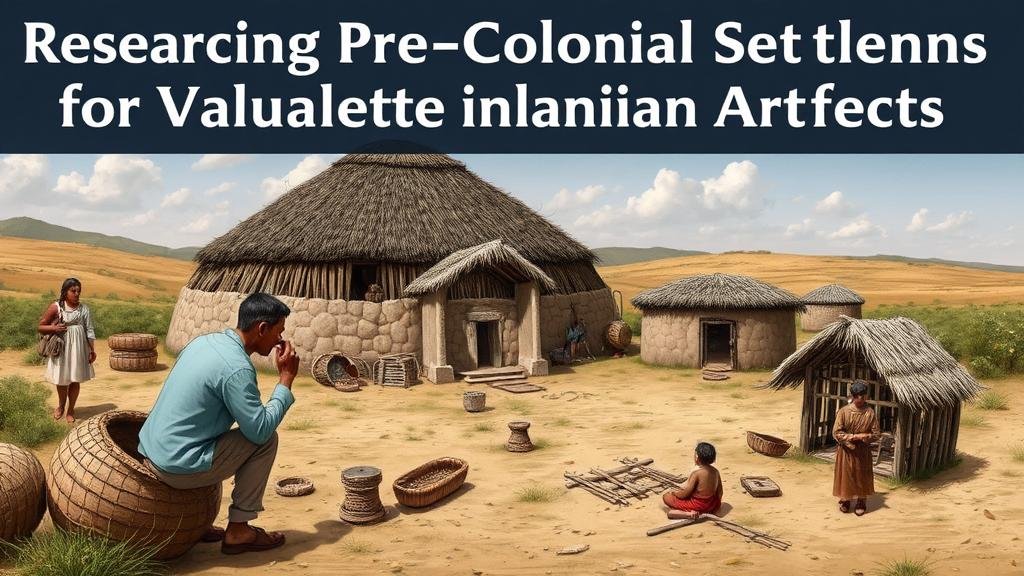Researching Pre-Colonial Settlements for Valuable Native Artifacts
Researching Pre-Colonial Settlements for Valuable Native Artifacts
The study of pre-colonial settlements remains a pivotal aspect of archaeology and anthropology, revealing insights into indigenous cultures and their interactions with the environment. Understanding these historical contexts not only enriches the narrative of human existence but also aids in the preservation of cultural heritage. This article explores methodologies, case studies, and the significance of researching these settlements in search of valuable native artifacts.
Historical Context of Pre-Colonial Settlements
Pre-colonial settlements in North America exhibit diverse cultural practices and societal structures that predate European contact. Notable settlements, such as Cahokia, located near present-day St. Louis, Missouri, thrived between 600 and 1400 CE. Cahokia was a significant urban center with an estimated population of 20,000 at its peak, displaying complex societal organization and elaborate mound constructions.
Another important case is that of the Ancestral Puebloans, who inhabited the Four Corners region of the United States. r settlements, such as Mesa Verde in Colorado, date back to around 600 CE, featuring cliff dwellings and extensive agricultural practices. These examples highlight the advanced state of indigenous societies prior to European colonization.
Methodologies for Researching Pre-Colonial Settlements
The process of researching pre-colonial settlements involves a multidisciplinary approach, integrating archaeology, historical analysis, and ethnobotany. Key methodologies include:
- Field Surveys: Systematic surveying of land through pedestrian or aerial reconnaissance helps identify potential settlement sites.
- Excavation Techniques: Stratigraphic excavation provides chronological context for artifacts and structures, allowing researchers to understand cultural layers.
- Remote Sensing: Techniques such as Ground-Penetrating Radar (GPR) and LiDAR can reveal hidden structures without invasive digging.
- Artifact Analysis: The study of materials, such as pottery, tools, and ornaments, aids in understanding daily life, trade networks, and technological advancements.
Significance of Native Artifacts
Native artifacts serve as critical evidence of the social, economic, and spiritual lives of indigenous peoples. Examples of significant artifacts include:
- Pottery: Functional and decorative pottery provides insights into artistic expression, dietary practices, and trade relations.
- Tools and Weapons: Stone tools and weapons reflect technological innovation and resource utilization in various environmental contexts.
- Textiles: The discovery of woven materials indicates sophisticated crafting techniques and cultural significance associated with clothing.
Case Studies of Successful Research
One remarkable case study is the exploration of the site of Chaco Canyon in New Mexico, which was a major center for the ancestral Puebloans. Archaeologists have uncovered a network of great houses that were once sites of trade and ceremonial gatherings. By analyzing the artifacts collected from these sites, researchers have reconstructed trade networks that connected Chaco Canyon to regions as far away as the Mississippi River.
Another notable example is the excavation conducted at the site of Etowah Mounds in Georgia. Dating back to 1000 CE, the mounds revealed intricately crafted jewelry and ceremonial artifacts that demonstrate the complex societal hierarchies and spiritual practices of the native tribes in that period. These findings underscore the importance of preserving archaeological sites to foster cultural understanding.
Challenges in Artifact Research
Conducting research on pre-colonial settlements and artifacts presents several challenges:
- Environmental Degradation: Erosion, urban development, and climate change threaten the preservation of archaeological sites.
- Legal and Ethical Issues: The protection of indigenous rights and repatriation of artifacts complicate research practices.
- Funding and Resources: Limited financial resources can hinder extensive archaeological studies and outreach programs.
Conclusion and Future Directions
Researching pre-colonial settlements is vital for understanding the rich cultural histories that preceded European colonization. As archaeological methods and technologies continue to advance, the potential to uncover valuable native artifacts expands. Collaboration with indigenous communities in research ventures provides holistic narratives that honor cultural perspectives and foster mutual respect.
For future research, it is essential to advocate for sustainable practices, integrate modern technologies effectively, and address the ethical implications of archaeological work. By doing so, scholars can contribute meaningfully to both the academic discourse and the cultural preservation of indigenous histories.
In summary, the significance of researching pre-colonial settlements and artifacts transcends historical curiosity; it offers a pathway to understanding our shared human heritage and the necessity to respect and preserve the legacies of native peoples.



